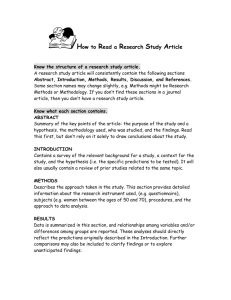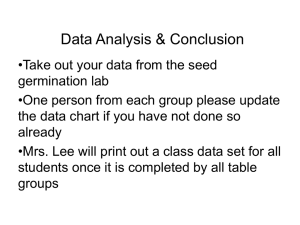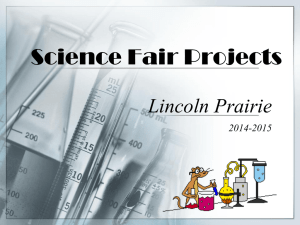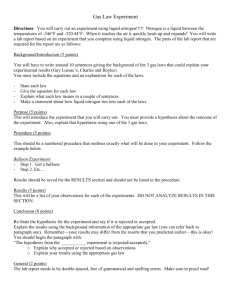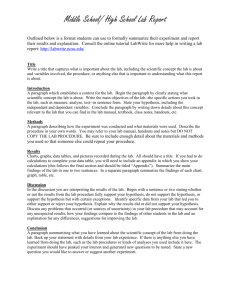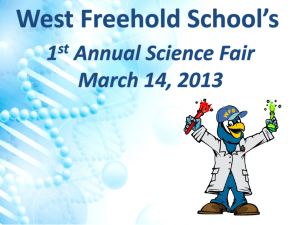Science Fair Sample
advertisement
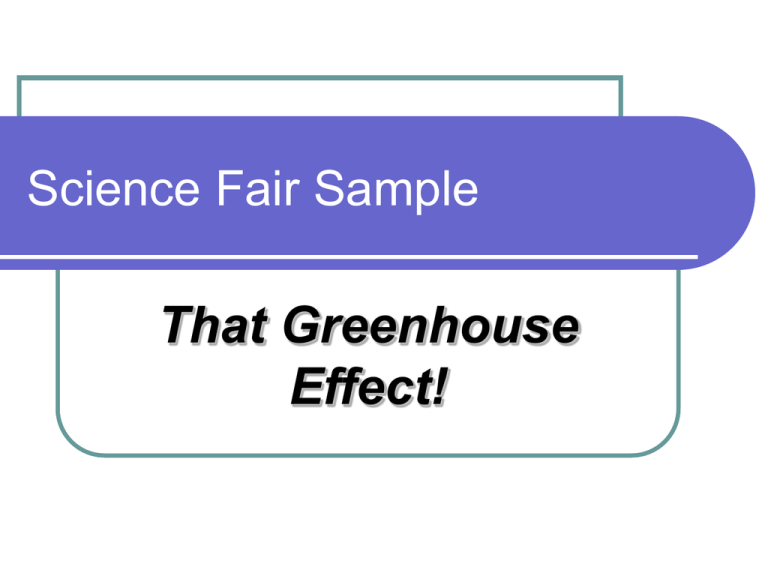
Science Fair Sample That Greenhouse Effect! Abstract Paragraph1: Paragraph 2: Purpose: The statement that explains why the student is doing the experiment Problem: The question telling what the student is trying to find out. Hypothesis: An explanation of what prompted the student‟s research, and what the student hopes to achieve, and what the student thinks the outcome might be (before doing the experiment). Procedures: A brief summary of how the experiment was performed & the key points Results: A brief description of the important results that lead directly to the student‟s conclusion-do not give too many details or include tables or graphs of data. Paragraph 3: Conclusions: A brief summary paragraph of why the experiment had those results and if your hypothesis was correct or incorrect. Appplications: A brief summary paragraph of how you think your results can be used by others and what you would differently in future experiments on this topic. Table of Contents A list of where to find specific information in the student‟s written report. Include page numbers (placed behind the Abstract summary). EXPERIMENT DESIGN Purpose The reason why the student is conducting this research and doing this experiment. Problem The question the research answers. In question format- the scientific question to be solved. It should be… open-ended question that is answered with a statement not a yes or no. Ex: “How does the color of light affect the growth of a plant?” Research The entire report should be typed (11-12 pt font), double-spaced, and placed 3-ring binder or folder with a clear plastic front, as it is a formal presentation of your science research project. The more thorough (more pages 2-3) your research is, the more points you will earn. Try to use at least three sources (books, internet sites, interviews). Students are to use Hypothesis The „educated guess‟ that is the answer to the problem. It is statement with a reason. The experiment is designed to test this hypothesis. Ex: “I believe that all plants need regular white light to grow. I base this hypothesis on the information I learned in my background research that showed me how plants convert light energy into food.” The format can be: I think…; It is my opinion that…; I believe…because or based upon….(the reason) or a cause and effect statement: If________________________________________________(wh at you plan to test), then (what you think will happen). Subject(s) Explain what organism, item or parameter the student is testing. Any matter, living or nonliving is the subject. Variables Independent Variable: The item the student purposefully changes, or is testing. **ONLY 1 Dependent Variable: The outcome being measured Controls The parameters you keep the same so that the experiment is valid. The items that do not change during the experiment that test the hypothesis. Materials A bulleted list of any supplies necessary to complete your study of the problem and testing of your hypothesis. Be sure to include the quantity of any items listed. (metric for middle school and advanced learners) Procedure Step-by-step process used to carry out the experiment. The experiment must be done at least three times to increase the validity of the results. It should be detailed so that someone would be able to repeat the experiment. Use numbers to list steps beginning with a verb (like in a recipe). Do not use pronouns in listing the steps. ** It is highly recommended to use the metric system. Data Tables, charts, graphs, diagrams to show the results of the experiment Results A breakdown, in summary form, of what happened in your experiment. Just give the facts not the interpretation (those are in your conclusion section). Example: Plant A grew 5 cm higher than Plant B after 2 weeks. INCLUDE STATISTICS (metrics is preferred when possible. Conclusion Specifically summarizes what the student has discovered, how the results compare to the hypothesis and why the hypothesis was supported/not supported. Review how the data related to any information the student has learned while doing his/her background research. Application A summary about how the project relates to real world problems or situations. Recommendations Indicate any changes or improvements to the experimental design Give possible extensions to the research. Acknowledgments The student gives credit to anyone who has helped them during the project. It is not a list of names, but a short paragraph stating the names of people who helped the student, and how they helped. Bibliography Properly formatted list of all sources and reference materials the student has used. (See itemized list of proper formats). Great resource for easy formatting: www.easybib.com Do NOT include search engines (google, etc)


